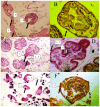Suppression of E. multilocularis hydatid cysts after ionizing radiation exposure
- PMID: 24205427
- PMCID: PMC3812096
- DOI: 10.1371/journal.pntd.0002518
Suppression of E. multilocularis hydatid cysts after ionizing radiation exposure
Abstract
Background: Heavy-ion therapy has an advantage over conventional radiotherapy due to its superb biological effectiveness and dose conformity in cancer therapy. It could be a potential alternate approach for hydatid cyst treatment. However, there is no information currently available on the cellular and molecular basis for heavy-ion irradiation induced cell death in cystic echinococcosis.
Methododology/principal findings: LD50 was scored by protoscolex death. Cellular and ultrastructural changes within the parasite were studied by light and electron microscopy, mitochondrial DNA (mtDNA) damage and copy number were measured by QPCR, and apoptosis was determined by caspase 3 expression and caspase 3 activity. Ionizing radiation induced sparse cytoplasm, disorganized and clumped organelles, large vacuoles and devoid of villi. The initial mtDNA damage caused by ionizing radiation increased in a dose-dependent manner. The kinetic of DNA repair was slower after carbon-ion radiation than that after X-rays radiation. High dose carbon-ion radiation caused irreversible mtDNA degradation. Cysts apoptosis was pronounced after radiation. Carbon-ion radiation was more effective to suppress hydatid cysts than X-rays.
Conclusions: These studies provide a framework to the evaluation of attenuation effect of heavy-ion radiation on cystic echinococcosis in vitro. Carbon-ion radiation is more effective to suppress E. multilocularis than X-rays.
Conflict of interest statement
The authors have declared that no competing interests exist.
Figures





References
-
- Bao YX, Zhang YF, Ni YQ, Xie ZR, Qi HZ, et al. (2011) [Effect of 6 MeV radiotherapy on secondary Echinococcus multilocularis infection in rats]. Zhongguo Ji Sheng Chong Xue Yu Ji Sheng Chong Bing Za Zhi 29: 127–129. - PubMed
-
- Bao YX, Mao R, Qi HZ, Zhang YF, Ni YQ, et al. (2011) [X-ray irradiation against Echinococcus multilocularis protoscoleces in vitro]. Zhongguo Ji Sheng Chong Xue Yu Ji Sheng Chong Bing Za Zhi 29: 208–211. - PubMed
-
- Ulger S, Barut H, Tunc M, Aydin E, Aydinkarahaliloglu E, et al. (2013) Radiation therapy for resistant sternal hydatid disease. Strahlenther Onkol 189: 508–9. - PubMed
-
- Phillips R, Murikami K (1960) Preliminary neoplasms of the liver. Results of radiation therapy. Cancer 13: 714–720. - PubMed
Publication types
MeSH terms
Substances
LinkOut - more resources
Full Text Sources
Other Literature Sources
Research Materials

